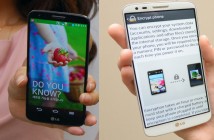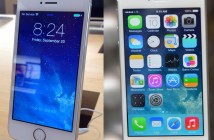
Of all the phones with a QWERTY keyboard (and there are quite a lot of them on the market at the moment), the Motorola Droid 3 and LG DoublePlay stand out the most. The first one is the successor to the venerable Droid and Droid 2, and has a pretty damn good landscape keyboard, while the second uses an unusual setup – a split landscape QWERTY keyboard and a small secondary display to achieve the best typing experience AND productivity at the same time. As both these phones are great for frequent and long typing, it’s interesting to see which one offers the best overall experience.
Exterior design and display(s)
The Motorola Droid 3 looks quite unique and stands out from the crowd when it comes to QWERTY smartphones. It’s got an industrial design that reminds more of the first Droid, with the same “lip” at the bottom and metal housing that looks like it could take a beating (it could, by the way). The metal back cover that was pretty good on the first two Droids was replaced with a plastic one, but that doesn’t stop it from being sturdy, thankfully. The slider mechanism is still springless, but if you’re switching from the Droid or Droid 2, you’ll feel right at home.
The LG DoublePlay looks and feels cheaper at a first glance – it’s got a round design, the housing is made mostly out of plastic (at least on the outside), and it is pretty thick, as well, at 16mm (the Droid 3 is 13mm, by comparison). It is a mid-range smartphone, but I think that LG could’ve gone with something better built. The slider is spring operated, and when you open the phone up, you see what’s different about it – the 2 inch display right in the middle of the keyboard.
The display on the Droid 3 is a nice 4 inch, 960×540 pixels PenTile unit, which uses less power and is brighter than normal LCDs. While the screen has increased in size over the previous 3.7 inch display, it still feels good in your hand and isn’t too big for your pockets. The LG DoublePlay can’t compare when it comes to screen quality – the main display is a 3.5 inch LCD unit with a resolution of 320×480 pixels, which is definitely on the (very) low side nowadays. The second display is 2 inches and has a 320×240 pixels resolution, and it’s pretty useful in a lot of apps, but it doesn’t really make up for the abysmal main screen.
Internal hardware and performance
Both phones have the usual hardware features set, including Wifi, Bluetooth, GPS, 4G radio and the standard set of sensors, but the Droid 3 has a HDMI out port, while the DoublePlay is missing it. The Droid 3 also has two cameras, an 8 megapixels unit on the front and a VGA one on the front, while the DoublePlay only has a 5 megapixels camera on the back and no video call capabilities. The Motorola also comes with 16 GB of internal storage space, while LG only installed 2 GB, but both phones have a micro SD card slot for expansion, so that shouldn’t be a problem.
The performance couldn’t be more different, though – the Droid 3, which is basically a high end phone, uses a dual core TI OMAP processor with the fast overclocked PowerVR SGX540 GPU, while the DoublePlay has a single core Snapdragon with the Adreno 205 GPU. The Snapdragon may be pretty fast in most apps, but it’s noticeably slower when it comes to more resource intensive apps, HD video playback and rendering Web pages. Both phones have only 512 MB, though, which will limit them in multitasking, but usually that’s not a big problem since Android can manage the memory pretty well.
The keyboard
Both the Droid 3 and DoublePlay have great keyboards, even though they’re following different design concepts. The Droid 3 has the traditional landscape slide-out keyboard, and with its big separated keys and large surface, it is one of the best ones on the market. The LG DoublePlay uses a split keyboard, and that makes it great for typing with two thumbs, but the size of the keys will make it a bit problematic for those with bigger thumbs. The keys are sufficiently raised and pretty well spaced, and it wouldn’t be hard to achieve very high typing speeds on the keyboard with a little training. The 2 inch display definitely helps in multitasking, as well.
Software
Both the Droid 3 and DoublePlay come with Android 2.3 Gingerbread pre-installed, and of course, both are customized by their respective manufacturers with a few skin changes and special features. For the Droid, it’s MotoBlur, with its tighter social integration. For the DoublePlay, the customizations are deeper, since LG needed to make the second display work in various apps and even let you use two different apps at once. Besides that, you get the full Android Gingerbread experience on both phones, although only the Droid 3 will receive an Ice Cream Sandwich update – probably, since it has only 512 MB of RAM (which is supposedly on the low side for ICS).
Overall, both phones are pretty good, but for different purposes. The Droid 3 is slightly more expensive, but it’s a great universal smartphone that is reliable, durable and can be used for most tasks, including writing a lot of text. The DoublePlay is the best choice if you’re a heavy texter and want an affordable phone that can increase your productivity or give you more freedom when working or playing.



